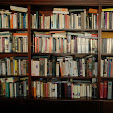We're having our floors redone, and in order for that to happen I had to empty my bookshelves so they could be moved. I pulled out a few books that I wanted to reread -- with the plan to donate or share them afterwards because I REALLY need to do something about my book problem. One step at a time. :) It's always interesting to reread a book that I read as a child; we cannot help but read it differently.
I think I originally read this when I was thirteen or so. I found it interesting that in her letter of 1947 that opens the second edition of the book, Betty writes of her gratitude for various people, including "a person who caused me much anguish because the grief made me grow up emotionally and gave me a little more understanding." (!) I enjoyed the story of a plucky, poor girl in Brooklyn. But there are parts of this book that suggest Smith is conveying her strong opinions and exorcising some of her own demons.
The book opens in summer of 1912 in Brooklyn. Francie Nolan and her brother Neeley live there, with their hardworking mother, Katie, and their shiftless but loving father, Johnnie, who cannot hold a regular job and is frequently "sick" (drunk). Aunt Sissy is scandalously sexual. The coming-of-age arc includes some ordinary and some striking moments: Francie finds the library; her father helps her attend a better school; the children earn a Christmas tree by standing still while an unsold one, on Christmas Eve, is literally thrown at them; after seeing an unmarried woman Joanna having stones thrown at her in the street, Francie "hated women. She feared them for their devious ways, she mistrusted their instincts"; Francie is attacked by a man in her building -- "the pervert"; her father dies; her mother remarries and they move out of Brooklyn.
Certain scenes feel polemical, or pedagogical, and often the author steps in to moralize. When Francie must get vaccinated for school, the doctor says,
"Filth, filth, filth, from morning to night. I know they're poor but they could wash. Water is free and soap is cheap. Just look at that arm, nurse." ... Francie stood hanging her head. She was a dirty girl.... [And then the author steps in:] A person who pulls himself up from a low environment via the boot-strap route has two choices. having risen above his environment, he can forget it; or, he can rise about it and never forget it and keep compassion and understanding in his heart for those he has left behind him in the cruel up climb.
Here's another interesting statement: "Married women were not allowed to teach in those days, hence most of the teachers were women made neurotic by starved love instincts. These barren women spent their fury on other women's children in a twisted authoritative manner. The cruelest teachers were those who had come from homes similar to those of the poor children. It seemed that in their bitterness towards those unfortunate little ones, they were somehow exorcising their own fearful background."
"An answer came to Katie. ... Education! That was it! It was education that made the difference! Education would pull them out of the grime and dirt!"
There is an extended section where Francie and Neeley argue over the existence of God -- if he's good, why did he let Father die? Francie recovers her faith within a few chapters.
I also got the feeling Smith was representing some of her own struggles in writing -- I wonder if she's mentally "outing" a teacher who gave her bad advice. Francie writes stories and ends up with a C- from her [narrow-minded] teacher who only wants her to write about nice things: "But poverty, starvation and drunkenness are ugly subjects to choose. We all admit these things exist. But one doesn't write about them."
Significant sections read like a cautionary tale for unmarried young women -- another horrible story is about a sixteen-year-old girl out in Maspeth; her father kept her on a diet of bread and water to weaken her so she and her child would die in childbirth.
And finally -- the various groups were singing on New Year's Eve, and the Germans won. Francie shivered. "I don't like Germans," she said. "They're so ... so persistent when they want something and they've always got to be ahead." Given that this was written in 1943, reissued 1947, it's not surprising.
The book is sixty years old, so it's dated, but it's also timeless, similar to the way other coming-of-age MG/YA books are. I'm glad I reread it, but after 40 years on my shelf, it's going in the donate stack for someone else to enjoy. :)


